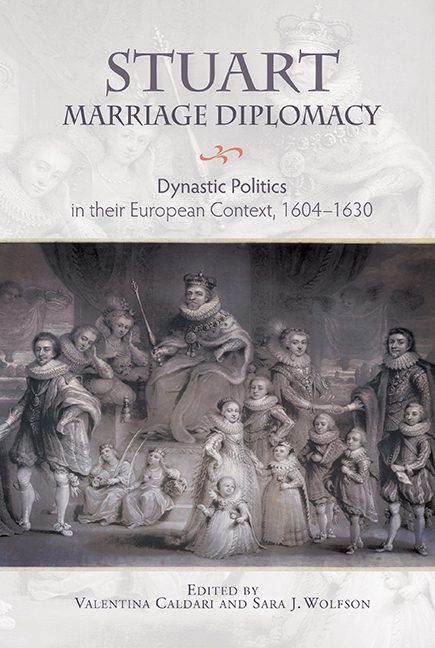Book contents
- Frontmatter
- Contents
- List of Illustrations
- List of Contributors
- Acknowledgements
- List of Abbreviations
- Introduction
- Part One Marriage and the Court
- Part Two Marriage and Politics
- Part Three Marriage and War
- Part Four Marriage and News
- Part Five Marriage and Continental Europe
- 15 A Peace in Context: Spanish Change in Italian Affairs
- 16 The Court in Brussels: From Hostility to ‘good vicinity’ (1585–1604)
- 17 The Austrian Match: The Habsburgs’ Dynastic Alternative and European Politics
- Part Six Marriage and Ceremony
- Bibliography
- Index
- Studies in Early Modern Cultural, Political and Social History
16 - The Court in Brussels: From Hostility to ‘good vicinity’ (1585–1604)
from Part Five - Marriage and Continental Europe
Published online by Cambridge University Press: 24 October 2019
- Frontmatter
- Contents
- List of Illustrations
- List of Contributors
- Acknowledgements
- List of Abbreviations
- Introduction
- Part One Marriage and the Court
- Part Two Marriage and Politics
- Part Three Marriage and War
- Part Four Marriage and News
- Part Five Marriage and Continental Europe
- 15 A Peace in Context: Spanish Change in Italian Affairs
- 16 The Court in Brussels: From Hostility to ‘good vicinity’ (1585–1604)
- 17 The Austrian Match: The Habsburgs’ Dynastic Alternative and European Politics
- Part Six Marriage and Ceremony
- Bibliography
- Index
- Studies in Early Modern Cultural, Political and Social History
Summary
The strategic importance of the Netherlands was recognized in the sixteenth century by both Spanish and foreign statesmen. This recognition is exemplified by the fact that in 1544, after much deliberating, Charles V's counsellors decided that it was less costly for the monarchy to renounce Milan than the Habsburg Netherlands. Undoubtedly, the importance of the Netherlands increased enormously following the outbreak of the Dutch Revolt, and especially in the last quarter of the sixteenth century, when the Spanish monarchy focused its attention on northern Europe, particularly on England and France. The Holy See exerted an unquestionable influence over these affairs. This chapter traces the crucial role of the court in Brussels in the period between 1585 and 1604, contextualizing the changing relations between the Habsburg Netherlands and France, the Holy See, and particularly England. First, however, we need to briefly consider the factions present at the court in Madrid, because the situation there undoubtedly influenced the policies that would be developed in the Habsburg Netherlands.
Factions at the court in Madrid and their influence on Brussels
When Philip II ascended to the throne, he inherited an unprecedented political entity that lacked common structures and included constituent territories ruled by a monarch who was physically absent. In order to manage this complex amalgam, Philip II decided to maintain the model his father had used successfully to keep all of his kingdoms united, which was to include landowning elites from his various dominions within his household. This system changed after a few years, when the ideals of the Castilian elites – who advocated Castilian hegemony within the monarchy – were imposed at court. The process of Confessionalization and the establishment of Madrid as the permanent seat of the court undoubtedly reinforced this trend, as these decisions were accompanied by measures designed, as far as possible, to ensure the symbolic presence of the sovereign in each of his states, even if he could not be there in person. Philip II was conscious of the fact that he needed to establish an organizational structure for his patrimony, so he discarded the composite model of monarchy and embraced the principle that political harmony was founded on territorial hierarchy and inequality, with Castile at the head of the monarchy, though this would not be achieved until the end of the sixteenth century.
- Type
- Chapter
- Information
- Stuart Marriage DiplomacyDynastic Politics in their European Context, 1604–1630, pp. 259 - 270Publisher: Boydell & BrewerPrint publication year: 2018



